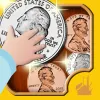
Digital Citizenship Week is October 20–24!
Join teachers worldwide to promote a healthy, positive approach to media and tech.
Take a look inside 5 images
Freefall Money
Pros: Fish tank rewards that build over time get kids to keep practicing.
Cons: Directions are only written -- there are no verbal instructions -- and the word nickel is misspelled.
Bottom Line: Freefall Money engages students with a bright user interface, progressive difficulty, and fun rewards for coin mastery.
Playing with coins is a good way for kids to begin to conceptualize why it's important to be able to count by fives, 10s, and 25s quickly. If you're introducing a lesson about skip counting, consider using Freefall Money to give students concrete examples. You can also use the coin-based problems here to get your students thinking about story problems in reverse. Have them use the coin exercises to create a story problem; this can encourage them to think about money counting in real-world, everyday-life math. As soon as your students begin learning about money, Freefall Money can be incorporated for solo or small group practice just as it is (as long as students can read the limited instructions to themselves). You may want to consider adding some real coins to their practice time on Freefall Money so they have the tactile as well as the digital experience of coins. An inexpensive game that's good to play for small bits of time, Freefall Money is also a great math app to recommend to parents for kids to use at home, especially kids who need extra money or skip counting practice.
Freefall Money is a coin-counting practice app that gives kids a fun way to learn and remember coins and their values. The money-based problems on the colorful screen are also an engaging way for kids to practice counting by ones, fives, 10s and 25s. Three modes of play -- fill the piggy bank with the requested amount of money using different combinations of coins, enter the amount of money available, and add up a group of coins -- appear progressively, as kids work from easy to difficult coin groups.
As long as kids have a basic familiarity with coins and their values and can read one- or two-sentence directions, you won't need to assist them much with playing Freefall Money. Before kids begin, choose which modes you'd like them to play, and what type and amount of coins will be included in the problems. Games are based on simply swiping the coins and dumping them into the correct bank or group, or typing correct numbers on a number pad. In Scatter Mode, kids fill a piggy bank with a requested amount of money by tapping on the correct coins scattered around the screen. In Type Mode, they type in the amount of money the coins are showing on the screen. Cluster Mode asks kids to add groups of coins. Once kids answer a few questions correctly, they get to tap on fish rewards to put into their virtual fish tank, which they can also clean and drop fish food into for fun.
Freefall Money is a low-stress way for kids to play around with coins without a focus on buying tons of stuff or amassing or running out of money. With big, shiny coins, organized numbers, cute piggy banks, and clear feedback on answers, kids focus on learning, not spending.
Freefall Money gives kids all the time they need to reflect on the coins they see and answer the problems given. The different modes and various ways of presenting coin counting throughout gameplay help build the concept that coins can be combined in many different groups and counted in a variety of ways to arrive at the same amount. These accurate exercises are relevant for young students not only to gain mastery of coin counting, but also to practice counting by ones, fives, 10s, and 25s, and a combination of them all. It would be nice if there were verbal as well as written instructions, but the written instructions are brief, and the images on the screen also act as clues for what kids should do. Freefall Money's fish tank reward system also helps bring kids back to the game repeatedly, which helps grow their coin-counting speed and comfort levels.
As of this review, the app has nickel misspelled, so teachers should reinforce the correct spelling.












